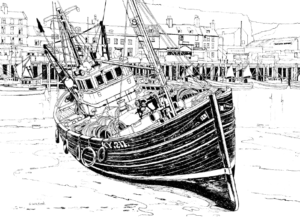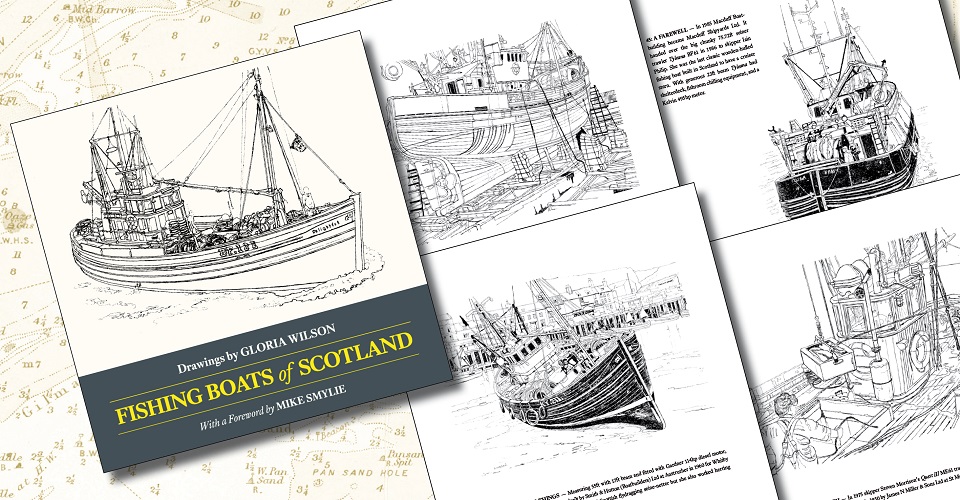 Gloria Wilson has been writing about, photographing and drawing the North Sea fishing industry for half a century. Of her drawings in particular she writes:
Gloria Wilson has been writing about, photographing and drawing the North Sea fishing industry for half a century. Of her drawings in particular she writes:
In making the drawings, with my own photographs for reference, I have enjoyed a mindful scrutiny of the boats and their singular spirit and magic, their idiosyncrasies and sometimes their unevenness. I feel that drawings rather than photographs are a better means of expressing these things, and I hope that the images are full of factual information and testimony, and convey a sense of the boats’ essential qualities.
All the more strange, then, that her drawings have not previously found favour with a book publisher. Mike Smylie, maritime historian, author, and kipper enthusiast, expresses the same view in his Foreword to Gloria’s Fishing Boats of Scotland:
When I first started researching fishing boats and those who work them, I was drawn to Gloria Wilson’s Scottish Fishing Craft and her subsequent More Scottish Fishing Craft, both being published by Fishing News Books in the second half of the 1960s. At that time the fishing industry was coming through the postwar changeable period: the herring was in fast decline, boats were modernising and adapting whilst new techniques were coming into play. Superstitions, though, were still alive so it was hardly surprising that there were some folk highly suspicious of a young woman—Gloria Wilson—embarking on many fishing expeditions and happily trudging through boatyard and quayside alike, questioning and photographing the people and vessels that were soon almost to disappear. There must have been some fishermen who looked on in complete shock—and denial—at the twenty-five-year-old spending time at sea, in all weathers, in what was then generally regarded as a man’s world. It was, we now know, pioneering work.
But Gloria Wilson was foremost an art teacher so it cannot come as any surprise that she was also producing lovely detailed line drawings of the boats she saw. Before her, her mother had been painting fishing boats and her father fishing, so the young growing-up girl must surely have had the fish/paint thing in her blood. Living alongside the sea in Staithes, on the Yorkshire coast, also provided her with ample inspiration. But with publishers preferring the more conservative photograph, it took another thirty years before these drawings first materialised in her published work: in two books from Hutton Press (Scottish Fishing Boats and Fishing Boats of Whitby and District) and even then we had only a glimpse. Photographs were still her main medium and this theme continued through the four books she has written for The History Press over the last decade, the most recent appearing in 2013.
Yet I recall contemplating these line drawings when first reading Scottish Fishing Boats. Looking back through past issues of the journal Fishing Boats, I find a review in the Spring 1999 issue in which I wrote of Fishing Boats of Whitby and District “She personalises the subject—and the boats—and introduces us to the folk who live and work these fine vessels” and go on to mention “her own superb line drawings [which] also add interest to these craft”. Thinking back, I remember wondering why there weren’t a lot more of them.
So, exactly half a century after she published her first book, at last we have a collection of these evocative drawings. In this book there’s a nice cross-section of boats from around the north-east of Scotland and the Yorkshire coast which, as she says in her introduction, “were the areas I know the best and where I have met the fisher people and their boats”. They represent a fishery of the rich North Sea almost gone, and many place a vessel not in isolation, but in the context of its work, with atmospheric detail. Not since Peter Anson’s Fishing Boats & Fisherfolk on the East Coast of Scotland (1930) and Ernest Dade’s sketch book of the North Sea, Sail and Oar (1933), have we seen such a fine collection of exacting and well-composed illustrations that I suggest echo Millet’s description of “the treating of the commonplace with the feelings of the sublime”. Thus it is indeed an honour to be able to recommend this book to a wide readership.

